|
"Ramming
Speed!"
Naval
Battles of the Ironclad Emperor of the Pacific
A Story of
bravery, honour, technology and bird droppings
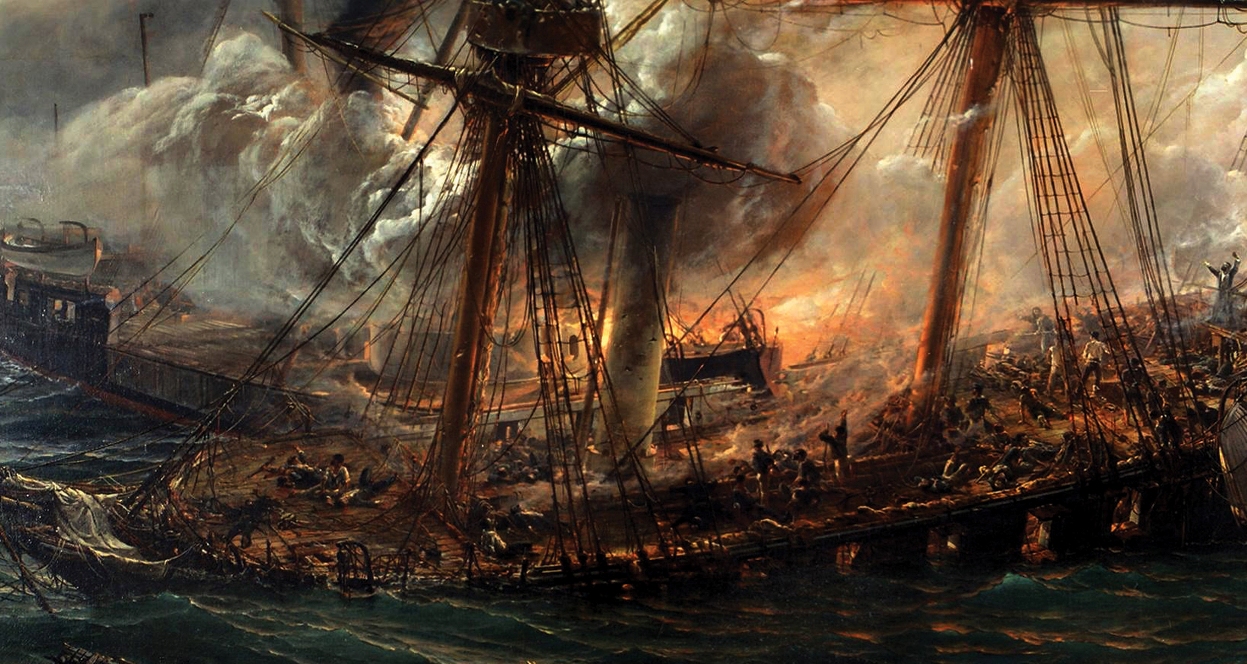
Named
after an Incan Emperor, the Peruvian Ironclad Huascar rams the
Chilean Corvette, Esmeralda at the Battle of Iquique (Thomas Somerscales)
Naval warfare
had shifted for good: wooden ships and iron men had been replaced
with iron ships and nerves of steel. The development of
steam-powered armoured warships had forever changed how combatants
engaged at sea. Steam power offered speed and maneuverability.
Armour provided protection for close-quartered movements and allowed
the vessel to endure raking fire that would have destroyed a wooden
ship. In short, an ironclad ship could get up close and personal.
Interestingly, this technological leap also heralded the re-birth of
the forgotten naval ram.

Ancient Greek and Persian ships using rams
decorated as ravens and wild boars.
Introduced by the Greeks in the 8th Century BC, the
wooden ram at the bow of a vessel was used to sink an enemy ship.
The ram was useless during the ensuing age of sail and artillery.
Indeed, to point your bow at another vessel meant certain death as
your ship was raked with cannon fire from enemy broadsides. For over
two centuries, naval fleet battles essentially consisted in two
lines of ships blasting away at each other, waiting for the wind to
offer advantage to either side. But on March 8, 1862, everything
changed.
As the American Civil War raged on, the Confederate ship Virginia
quietly slipped out of harbour. Covered in iron and sporting a ram,
the Virginia put the theories of contemporary naval
tacticians to the test. The USS Cumberland, a 38-gun wooden
enemy frigate, was rammed and sunk at surprising speed.
Unfortunately for the Confederate crew, their poorly-secured ram
went down with the enemy ship. Still, by the end of the day, the
Virginia had beached two other enemy ships with its artillery,
while suffering minimal damage.
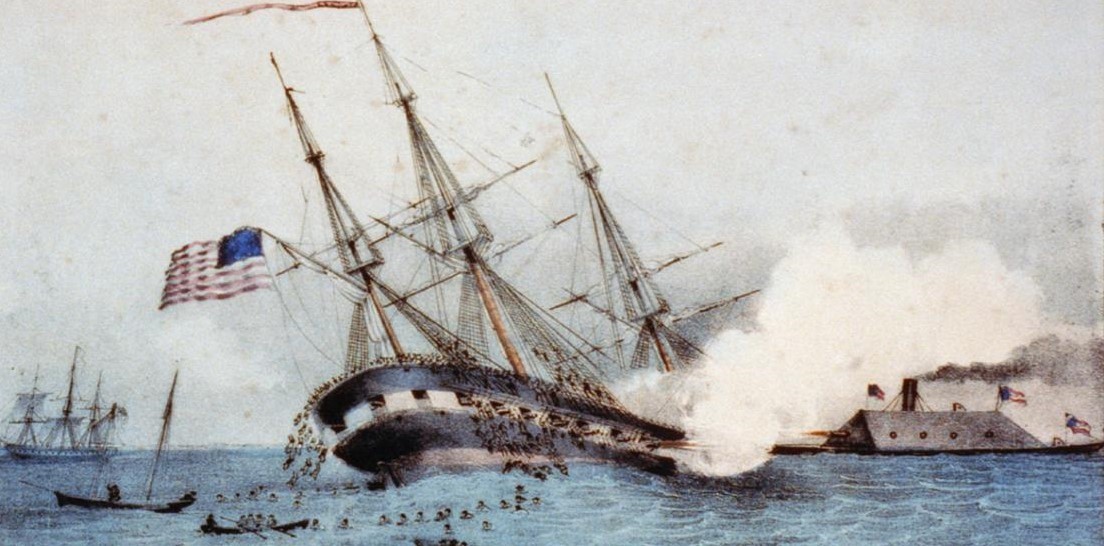
Ironclad CSS Virginia rams and
sinks the USS Cumberland
Sunrise brought the Union’s response: the ironclad USS
Monitor. The
Virginia answered the call and the world’s first encounter between
ironclads began. The two ships fired at each other relentlessly over four
hours, continually bouncing iron shot off the other’s haul, like armoured
knights smashing each other with maces. A hull breach was not likely for
either ship: stalemate. This thunderous artillery duo also sounded a death
knell for the wooden warship. It was only a matter of time before ironclads
were designed to be sea worthy and ventured off the coastline.

The CSS Virginia and USS Monitor bounce rounds off each other’s armour. A
frustrated Confederate officer commanding a gun said
he did the same damage to the Monitor “by snapping his fingers at her every
two and half minutes.”
The pings of cannon shot hitting armour that day reverberated around
the world as navies scrambled to adjust to this new tactical
reality. Steam-powered wooden ships were faster, but it was certain
death if they allowed an ironclad to close in on them. Soon, mixed
fleets of ironclad frigates and wooden ships challenged each other
on the open sea.
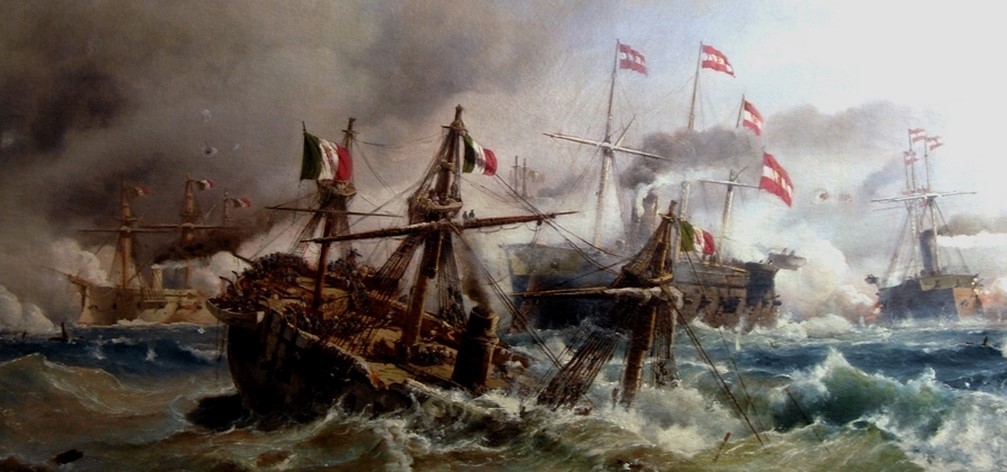
Battle of Lissa, 1866. Italian Ironclad sinks. Marines on deck give a
parting volley of defiance at the Austrian ironclad frigate that sunk their
ship.
At war, the Italian and Austrian fleets met in combat off the Island
of Lissa on July 20, 1866. Over forty vessels engaged. The Italian
ironclads identified the towering Austrian three-decker, 90-gun
wooden ship Kaiser (German for “emperor”) as the enemy’s flag
ship and swarmed it. Lacking maneuverability because of its size,
the Kaiser was soon rammed and forced from the battle.
Ironclads had successfully engaged in open sea.
Like the great powers, smaller nations embraced the ironclad’s
future. Peru was one country to join the movement out of
necessity. Spain began to reassert itself over its former South
American colonies. Spain’s dispute with Peru? Strangely, it was
bird dung. Millions of tons of bird droppings, called guano. High in
nitrates, guano was a much-sought-after fertilizer, similar to
potash today. There was a fortune in bird droppings to be had on the
Peruvian Chincha Islands and Spain wanted it.

The Great Guano Heap, or a mountain of bird crap that started a war.
After trumping up a collection of excuses, Spain sent a fleet to
occupy the islands in 1864. Accompanying the Spanish naval
expedition was the ironclad frigate Numancia. After the war
for the Chincha Islands, the Numancia would become the first
ironclad to circumnavigate the globe.
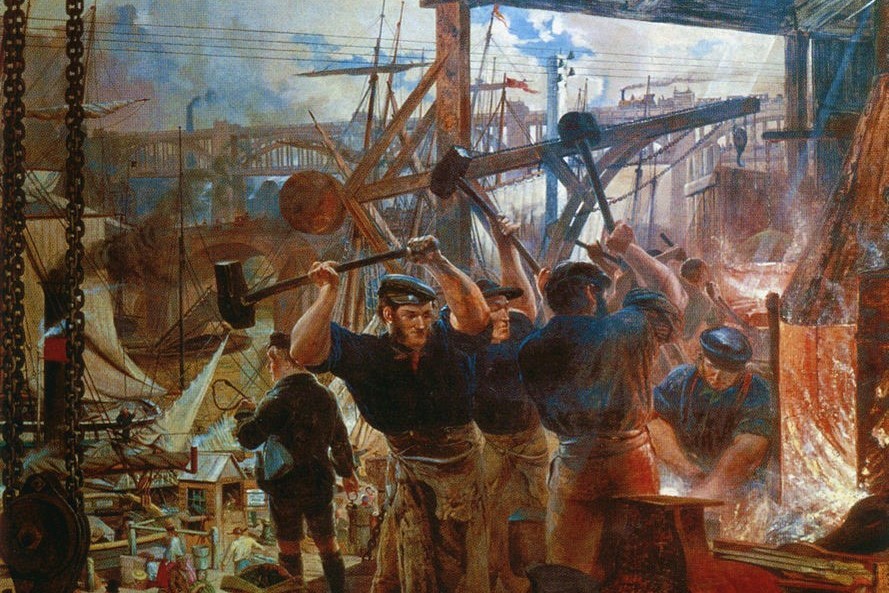
British
Shipyard workers in Iron and Coal by William Bell Scott,
1860.
Hopelessly outgunned by the Spanish fleet, Peru turned to British
shipbuilders for a solution. Peru spent what would today be the equivalent
of tens of millions of dollars to commission the building of two ironclads:
a frigate and a turret ship. The latter ship’s design had a turret similar
to the USS Monitor but mounted on an ocean-worthy ironclad ship. The
turret housed British state-of-the-art artillery: two Armstrong guns capable
of firing 300lb rounds. Delighted at the strength of their turret ironclad,
the Peruvians named it Huascar, after its most famous Incan emperor,
and made it their flagship.
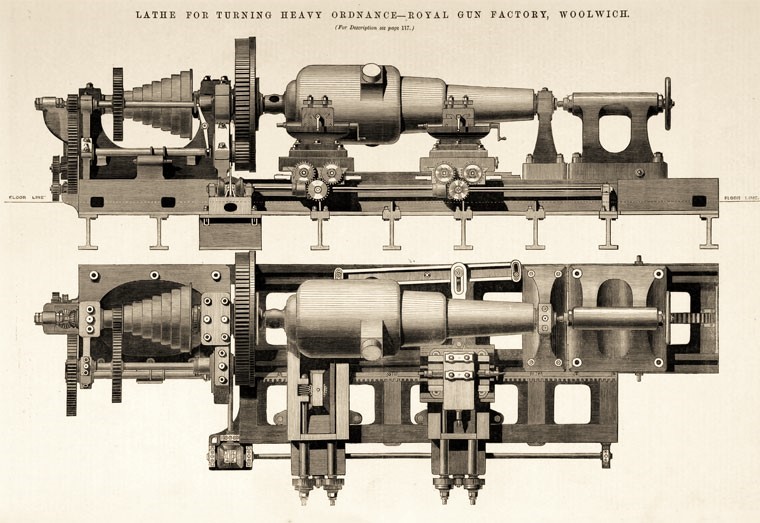
Barrel of a heavy
Armstrong Gun being lathed in England. 1867. The Huascar had Armstrong
Guns with 10-inch muzzles.
Completed in January 1866, the Peruvian ironclads set sail for their
new home. After a number of delays, the Huascar arrived in
the war zone in June. Meanwhile, having been denied access to coal
along the South American coast, the Spanish broke off their
half-hearted war with Peru and set sail for the Philippines. Peru
and Chile contemplated an attack on the Spanish in the Philippines
but the idea was ultimately abandoned. Still “the Emperor”
Huascar had arrived in the Pacific and ironically, its first
real fight would be against its creators.
In 1877 political intrigue brought Peru to the brink of civil war.
Rebels wishing to overthrow the country’s president daringly seized
control of the Huascar while at dock on May 6 and put it to
sea with piracy in mind. Their strategy was to destabilize Peru’s
trade by commandeering the ship and showing the weakness of their
reigning president. In its brief time as pirate, the Huascar
interfered with a British mail steam ship and stole coal from
another British vessel. It was unacceptable to Great Britain that a
small but well-armed rogue ironclad was preying on Pacific coast
merchant vessels and the Royal Navy responded.
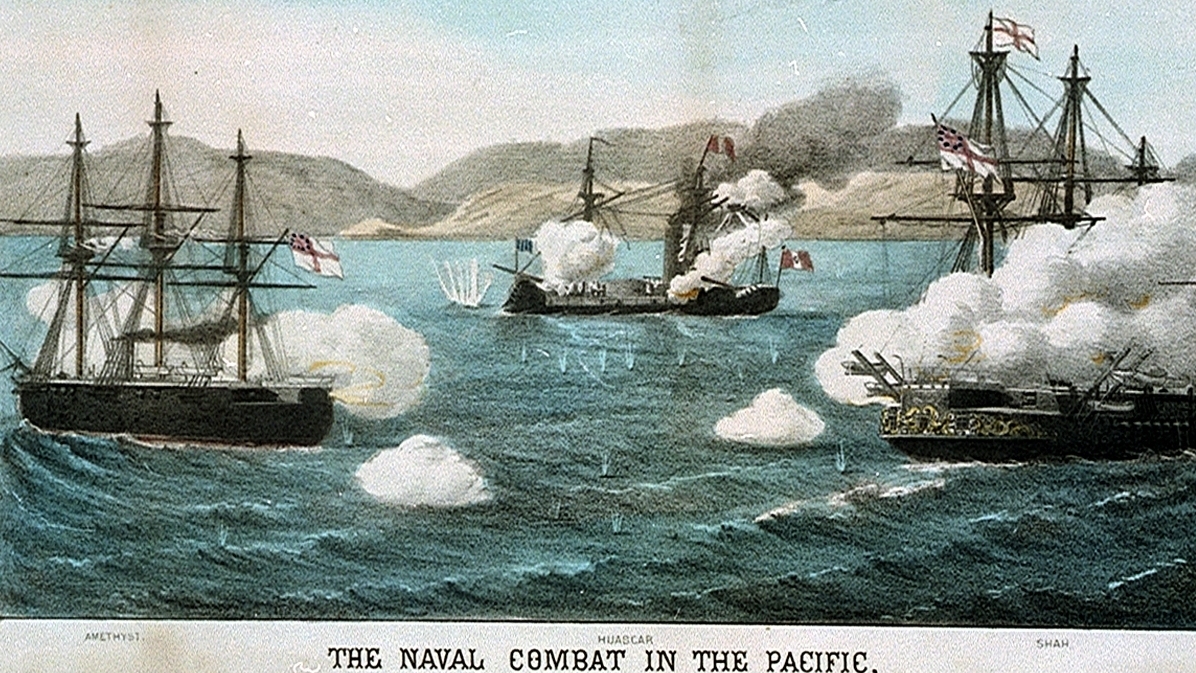
HMS Shah
and HMS Amethyst engage the Peruvian Rebel Ironclad Turret
Ram Huascar.
On May 29, two wooden British frigates, HMS Shah and HMS
Amethyst confronted the Huascar off the southern coast of
Peru near the town of Ilo. The rebels were surprised to see British
ships and even more astounded when they demanded the Huascar’s
surrender. The Huascar’s crew felt their infractions against
British property verged on trivial. Sensitive to any imperial
interference, Peruvian rebels were insulted by the Royal Navy’s
intrusion into what they saw as an internal affair. The Huascar
refused to surrender and the British open fired.
However, the British had built the Huascar well and the guns
of the Royal Navy ships could not damage it. To the relief of the
British crews, the Peruvian rebels were terrible gunners and could
not bring their lethal artillery to bear. Superior Royal Navy
training also allowed the British frigates to maneuver around the
Huascar’s attempts at ramming. After three hours of fighting,
the small and rapid Huascar retreated, but the British had
another card to play.

Whitehead
Torpedo, 1877. A.-B. The Charge Chamber of sheet iron. B.-C.
Adjustment Chamber of sheet iron.
C.-D. Air chamber and engine room of steel. E. Propeller F.
Vertical exploding Lever.
The British HMS Shah was fitted with a new weapon, never
before used in combat by the Royal Navy: The Whitehead Torpedo. This
self-propelled “locomotive” torpedo was sighted and launched at the
fleeing Huascar. In the end, the speed of the Peruvian
ironclad and its distance from the Shah outmatched the
British torpedo. The Royal Navy’s first battle in history with an
ironclad ended. Soon after, the rebels surrendered the Huascar
back to the Peruvian Navy. As a strange twist in the story, even
though the British had fought the rebels, the Peruvian government
lodged a formal diplomatic complaint against Great Britain for their
attack on the Huascar. Clearly Peru cherished both its
independence and the Huascar. But another war lurked on
the horizon, and Peru would need its little ironclad Emperor.
CONTINUE TO THE EXCITING FINAL PART
>>>>>>
 |
Author
Robert Henderson enjoys unearthing and
telling stories of military valour, heritage, and sacrifice
from across the globe. Lest we forget.
|
|